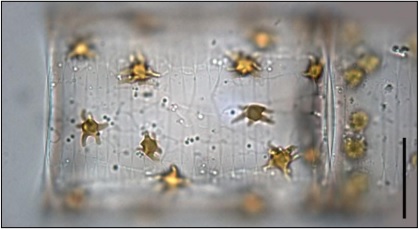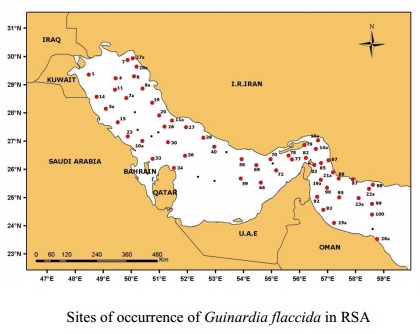Guinardia flaccida Péragallo
 Division: Chromophyta
Division: Chromophyta
Class: Bacillariophyceae
Order: Biddulphiales
Suborder: Rhizosoleniineae
Family: Rhizosoleniaceae De Toni
Genus: Guinardia H. Péragallo
Scientific name: Guinardia flaccida (Castracane) H. Péragallo

Species: flaccida
Synonyms:
Rhizosolenia flaccida Castracane; Rhizosolenia castracanei Cleve
References:
Pavillard, 1925: p. 24, Fig. 36; Hustedt, 1930: p. 563, Fig. 322; Allen and Cupp, 1935: p.124, Fig. 28; Cupp, 1943: p. 78, Fig. 40; Crosby and Wood, 1958: p. 524, Pl. 39: 79; Hendey,1964: p. 141, Pl. V: 5; Simonsen, 1974: p. 30; Ricard, 1987: p. 175, Figs. 241-249;Throndsen et al., 2007: p. 156.
Description:
Cells typically cylindrical, one and a half to several times longer than broad, single or united in chains by whole valve surface. Valve nearly flat, very slightly concave, with an irregular tooth at the margin. Diameter 30-53 µm. Cell wall weakly siliceous, collapsing when dried,without visible sculpturing. Chromatophores lying near the wall, round to biscuit-shaped,more or less lobed or cleft plates in large numbers, with one pyrenoid. Nucleus more or less central (Cupp, 1943).
Harmful Effect:
Non-toxic, but harmful bloom forming species. Harmful effects have been recorded in 1980 within South China Sea: death of fish and invertebrates was observed, resulting in the reduction of fish mariculture output and tourism was affected in this area (Yan et al., source:web-site).
Dimensions:
Cells length 60-75 µm; diameter 33-44 µm.
Distribution:
Neritic, south temperate species.
Sites of occurrence in RSA:
In Winter 2006 Cruise, this species was commonly observed in many sites (refer sites map),often in large numbers; maximum abundance (8.9*10^3cells/l) was associated with the northwestern part of the inner RSA (St. 7). It has been previously reported from the inner RSA (Simonsen, 1974) and from Kuwaiti waters (Al-Yamani et al., 2004; Al-Kandari et al., 2009).



